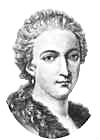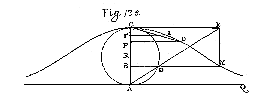


May 16, 1718 - January 9, 1799
Even though her contribution to mathematics are very important, Maria Gaetana Agnesi was not a typical famous mathematician. She led a quite simple life and she gave up mathematics very early. At first glance her life may seem to be boring, however, considering the circumstances in which she was raised, her accomplishments to mathematics are glorious. Enjoy!
In Italy, where the Renaissance had its origin, women made their mark on the academic world. Intellectual women were admired by men, they were never ridiculed for being intellectual and educated. This attitude enabled Italian women to participate in arts, medicine, literature, and mathematics. Among many others, Maria Gaetana Agnesi was by far one of the most important and extraordinary figure in mathematics during the 18th century.
"Maria Gaetana Agnesi was born in Milan on May 16, 1718, to a wealthy and literate family" [Osen, 39]. She was the oldest of the 21 children that her father, a rich merchant, had with his three wives. "She was recognized as a child prodigy very early; spoke French by the age of five; and had mastered Latin, Greek, Hebrew, and several modern languages by the age of nine. At her teens, Maria mastered mathematics" [Osen, 40]. The Agnesi home was a gathering place of the most distinguished intellectuals of the day. Maria participated in most of the seminars, engaging with the guests in abstract philosophical and mathematical discussions. Maria was very shy in nature and did not like these meetings. She continued participating in the home gatherings to please her father until the death of her mother. Her mother's death provided her the excuse to retire from public life. She took over management of the household. It is possible that this heavy duty job was one of the reasons why she never married.
However, she did not give up mathematics yet. In 1738 she published a collection of complex essays on natural science and philosophy called Propositiones Philosophicae, based on the discussions of the intellectuals who gathered at her father's home. In many of these essays, she expressed her conviction that women should be educated.
By the age of twenty, she began working on her most important work, Analytical Institutions, dealing with differential and integral calculus. "It is said that she started writing Analytical Institutions as a textbook for her brothers, which then grew into a more serious effort" [Osen, 41]. When her work was published in 1748, it caused a sensation in the academic world. It was one of the first and most complete works on finite and infinitesimal analysis. Maria's great contribution to mathematics with this book was that it brought the works of various mathematicians together in a very systematic way with her own interpretations. The book became a model of clarity, it was widely translated and used as a textbook. [See cover page, translation by John Colson at Google Books or American Libraries Internet Archive, the original Italian version, or excepts (version 1, version2) from the MAA Convergence Mathematical Treasures]
Analytical Institutions gave a clear summary of the state of knowledge in mathematical analysis. The first section of Analytical Institutions deals with the analysis of finite quantities. It also deals with elementary problems of maxima, minima, tangents, and inflection points. The second section discusses the analysis of infinitely small quantities. The third section is about integral calculus and gives a general discussion of the state of the knowledge. The last section deals with the inverse method of tangents and differential equations.
 Maria Gaetana Agnesi is best known from the curve called the "Witch
of Agnesi" (see illustration from her text Analytical Institutions). Agnesi wrote the equation of this curve in the form
\(y = \frac{ax}{\sqrt{ax-x^2}}\)
because she considered the x-axis to be the vertical
axis and the y-axis to be the horizontal axis [Kennedy]. Reference frames
today use x horizontal and y vertical, so the modern form of the curve
is given by
the Cartesian equation
\(yx^2 = a^2(a-y)\) or \(y = \frac{a^3}{x^2+a^2}\).
It is a versed sine curve, originally studied by Fermat. "It
was called a versiera, a word derived from the Latin vertere,
meaning 'to turn', but it was also an abbreviation for the Italian
word avversiera, meaning 'the wife of the devil'" [Osen, 45]. However,
when Maria's text was translated into English the word versiera
was confused with "witch", and the curve came to be
known as the witch of Agnesi.
Maria Gaetana Agnesi is best known from the curve called the "Witch
of Agnesi" (see illustration from her text Analytical Institutions). Agnesi wrote the equation of this curve in the form
\(y = \frac{ax}{\sqrt{ax-x^2}}\)
because she considered the x-axis to be the vertical
axis and the y-axis to be the horizontal axis [Kennedy]. Reference frames
today use x horizontal and y vertical, so the modern form of the curve
is given by
the Cartesian equation
\(yx^2 = a^2(a-y)\) or \(y = \frac{a^3}{x^2+a^2}\).
It is a versed sine curve, originally studied by Fermat. "It
was called a versiera, a word derived from the Latin vertere,
meaning 'to turn', but it was also an abbreviation for the Italian
word avversiera, meaning 'the wife of the devil'" [Osen, 45]. However,
when Maria's text was translated into English the word versiera
was confused with "witch", and the curve came to be
known as the witch of Agnesi.
After the success of her book, Maria was elected to the Bologna Academy of Sciences. The university sent her a diploma and her name was added to the faculty. However, there is a debate over whether or not Maria accepted this appointment since by this time she had devoted herself to her work with charity. It seems that her father was the inspiration for her interest in mathematics. When he died in 1752, Maria gave up any further work in mathematics. "When, in 1762, the University of Turin asked her for her opinion of the young Lagrange's recent articles on the calculus of variations, her response was that she was no longer concerned with such interests" [Osen, 47].
Maria was a very religious woman. She devoted the rest of her life to the poor and homeless sick people, especially women. When the Pio Instituto Trivulzo, a home for the ill and infirm, was opened, Maria was given an appointment as the director of the institute. She took care of ill and dying women until her own death.
It seems to me that even though she was a genius, mathematics was only a temporary hobby of hers. It may be that she was only dealing with mathematics to please her father who apparently was expecting his prodigy child to be involved in mathematics. Of course, this is only a personal observation. However, her behavior implies that she was not dedicated to mathematics which I think explains why she gave up mathematics altogether as soon as her father died. She was a very shy and decent person. She was not ambitious to become a well-known mathematician. Her most famous work, Analytical Institutions, was intended to be a textbook for her brothers. Her intelligence and talent made it possible to integrate all the state of the art knowledge about calculus in a very clear way. Religious life and helping the needy seem to have interested her more than mathematics.
April 1995
Notes by Larry Riddle
Maria Gaetana Agnesi's younger sister, Maria Teresa Agnesi, was a composer, harpsichordist, singer and librettist. She was born on October 17, 1720. While still a teenager, she would perform in her home while her older sister lectured and debated in Latin. Her first theatrical work, Il ristoro d'Arcadia, was successfully presented in Milan in 1747. She wrote seven operas of which three were based on her own librettos. The Empress Maria Theresia was known to sing from a collection of arias that Maria Teresa Agnesi had composed for her. In 1752 she married Pier Antonio Pinottini but had no children. She died on January 19, 1795. Her portrait hangs today in the theatre museum of La Scala.
Here are three of the keyboard pieces composed by Maria Teresa Agnesi. To listen to these pieces you will need to configure your browser to play midi files.
Sonata per il Clavicembalo
(Allegro and Menuet)
Sonata in G Major
Allegro ou Presto in A Major
The Canadian composer Elma Miller has written a work called "The Witch of Agnesi" for B flat clarinet, bass clarinet, horn, 2 percussion, viola and double bass. The work was commissioned by the Alliance for Canadian New Music Projects and was first performed in late October 1989 in Toronto. Despite its premier performance so near Halloween, the inspiration for the piece was the curve of Maria Agnesi! In the program notes Miller writes that "The witch of Agnesi refers to a well known mathematical curve, roughly in the shape of a mantelpiece clock. Melodic lines of this shape appear throughout the piece in both large and small scale representations." You can listen to an archival recording at the website for the Canadian Music Centre Music Library (free registration required for access to the recordings).